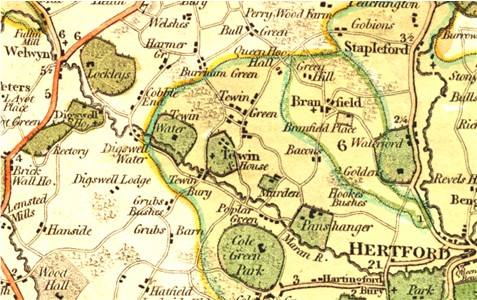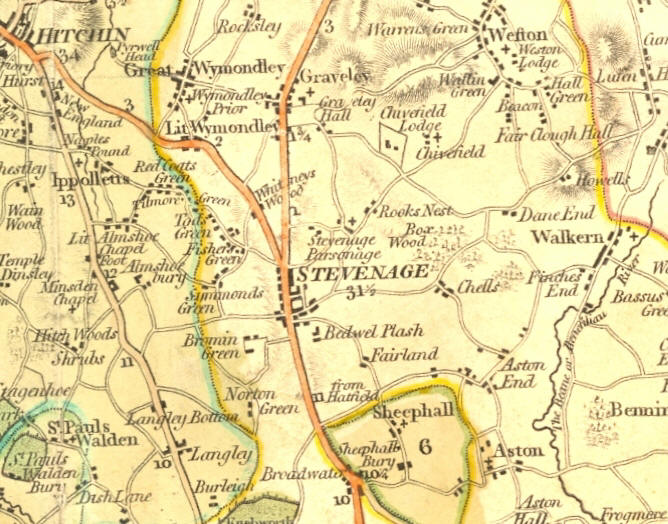- Richard Gynne or Ginn, 1307, Poll Tax/Lay Subsidy for Hertfordshire (GHB)
- John Gynne, 1401, Welwe
CP40/561: K-Z: Easter Term, 1401, sorted by plaintiff (By Rosemary Simons)
f/d Image County Case Type Plaintiff Defendant d 1459 Herts debt Sokes, John Porter, Robert; Whatton, Thomas; Gynne, John, of Welwe; Holstok, John; Smyth, John, of Welwe; Willyam, John, of Hertford; Whithed, John Welwe is now known as Welwyn; Major Settlement in the Parish of Welwyn. Historical Forms include Welwe (Feudal Aids). Adjacent to Digswell (Digswell House was at one time owned by the Perient family) and very close to Panshanger which was owned by Hugh Gynney and by Walter de Gynney or Gisney in the first half of the 13th century. (see: Hugh_de_Gynney_1262_Hertfordshire.txt)
Source: Survey of English Place-Names, U Nottingham.
This map by Charles Smith from 1808 shows the locations of Welwyn, Digswell House and Panshanger.
(source: http://www.hertfordshire-genealogy.co.uk/data/places/places-d/digswell/digswell.htm) - William Gynne, 1408, Hertfordshire
CP40/589: K-Z: Easter Term, 1408, sorted by plaintiff name K-Z (By Rosemary Simons)
Roll/f or d Image County Pleas Plaintiffs Defendants d 1504 Herts trespass: close, taking oxen Perers, Richard, of Chesthunt Baron, Robert, of Staundon; Hyve, John; Gynne, William - Thomas Gyn, 1440, Aston
Thomas Gyn of Aston Very likely this man is an ancestor of William Ginn (d. 1520). But we can't know this from information currently available. All we know is that he was alive in 1440, before William was born, and he was well enough situated to have a servant. He may be father, grandfather, uncle or cousin. He appears to also have a connection to a 'John Peryen of Digswell', judging by the fact that both these men had servants with the same last name. Found at: England’s Immigrants Database 1. This man is shown as a servant of one Thomas Gyn of Aston in 1440 Peter Perot [592] Surname: Perot Forename: Peter Gender: Male Place of Residence: Aston, Broadwater hundred, Hertfordshire Occupation(s): servant to Thomas Gyn of Aston Taxation Status: non-householder Original Document: E 179/120/83, m. 3 (tax assessment, 1 June 1440) Notes: No Notes Biographical Notes: No Notes Relationships: No Relationships https://www.englandsimmigrants.com/person/592 Probably same person: E 179/120/87, m. 1 (tax assessment, 31 August 1441) https://www.englandsimmigrants.com/person/1405 2. A probable relative of Peter (above) is shown as a servant of one John Peryen of Digswell also in 1440 John Perot [528] Surname: Perot Forename: John Gender: Male Place of Residence: Digswell, Broadwater hundred, Hertfordshire Occupation(s): servant to John Peryen Taxation Status: non-householder Original Document: E 179/120/83, m. 3 (tax assessment, 1 June 1440) The database does not state where these men are from or if they are related. 3. A John Perot is shown as Irish, from Ireland in Croxton, Cambridgeshire in 1394 John Perot [21259] Surname: Perot Forename: John Gender: Male Place of Residence: Croxton, Longstow hundred, Cambridgeshire Place of Origin: Ireland Origin: Nationality: [Irish] Original Document: CPR 1391-6, p. 460 (licence to remain, 27 July 1394) Notes: Paid 6s. 8d. Biographical Notes: No Notes Relationships: No Relationships https://www.englandsimmigrants.com/person/21259 The database does not state if this is the same man or if these men are related. https://www.englandsimmigrants.com/person/528
- John Gynne, 1453, quitclaim in Feet of Fines, Ware
CP 25/1/91/116, number 167. John Gynne and Joan, his wife Link: Image of document at AALT http://aalt.law.uh.edu/CP25%281%29/CP25%281%29Herts91/B/IMG_0048.htm County: Hertfordshire. Place: Westminster. Date: The day after St John the Baptist, 31 Henry VI [25 June 1453]. Parties: Philip Boteler, esquire, Thomas Braughing, John Gynne and Joan, his wife, and Thomas Bole, querents, and John Brid' and Margaret, his wife, deforciants. Property: 1 messuage in Ware. Action: Plea of covenant. Agreement: John Brid' and Margaret have acknowledged the messuage to be the right of John Gynne, as that which the same John and Joan, Philip, Thomas and Thomas have of their gift, and have remised and quitclaimed it from themselves and the heirs of Margaret to Philip, Thomas, John Gynne and Joan and Thomas and the heirs of John Gynne for ever. Warranty: Warranty against John, prior of Hertford, and his successors. For this: Philip, Thomas, John Gynne and Joan and Thomas have given them 20 pounds sterling. Standardised forms of names. (These are tentative suggestions, intended only as a finding aid.) Persons: Philip Butler, Thomas Braughing, John Ginn, Joan Ginn, Thomas Bool, John Bride, Margaret Bride Places: Ware http://www.medievalgenealogy.org.uk/fines/abstracts/CP_25_1_91_116.shtml
- John Gynne, 1470, Hoddesdon
Henry VI, 1470: CP40no837; By Rosemary Simons John Gynne Side:f Image:199 County:Herts Case Type:debt Plaintiff:Tye, William, of Hoddesdon Defendant:Chaumberleyn, John, of Steeple(?), Cambs, husbandman; Bagge, John, of Stepil Mordon, Cambs, husbandman; Gynne, John, of Hoddesdon, husbandman; Sampson, John, of Ware, Herts, tiler; Mordon, Richard, of Ge--(?), Herts, collier http://aalt.law.uh.edu/Indices/CP40Indices/CP40no837/CP40no837Cty.htm
- John Gynne, husbandman, 1472, Hoddysdon
CP40/841: Hilary Term 1472; Sorted by Plaintiff (By Vance Mead)
Side Images Pleas County Plaintiffs Defendants d 1254 debt London Ryche, Katherine, widow, executor of; (Renkyn, John, of London, mercer) Cokk, Lawrence, of Monmouth, Glos, chapman; Mercer, Pter, of Bristol, chapman; Burgeys, Richard, of Leicester, chapman; Appulby, John, of Oswestre, March of Wales, chapman; Gynne, John, of Hoddysdon, Herts, husbandman - Thomas Gynn, 1482, Stevenage
Hertfordshire Record Society Newsletter No 19 Spring 2005 Forthcoming Volume XXI The Hellard Almshouses and other Stevenage charities, 1482 – 2005, edited by Margaret Ashby Thomas Gynne of Stevenage 1482 In Church Lane, Old Stevenage, is a row of unpretentious cottages with a history reaching back to the 15th century. These are the Stevenage Almshouses, also known as the Hellard Almshouses, after their founder, Rector Stephen Hellard. According to the Alumni Cantabrigiensis Stephen Hellard was a member of Cambridge University, graduating as a Bachelor of Law in the year 1474-75. It is also suggested that he was 'Perhaps Doctor of Canon Law in 1492' but in his will he claims only to hold the degree of Bachelor of Arts. His date of birth is not given, but he is recorded as being 'of Yorkshire.' He was probably Rector of Upminster, Essex, from 1470 to 1472, after which, on 3rd July 1472, he was installed as Rector of Stevenage and lived there until his death in 1506. He was, however, also a prebendary of St Asaph's cathedral, which may have involved him in occasional residence there. Stephen Hellard died in 1506, leaving in his will a legacy to the town of All Christian Souls House, ‘which house I have built for the habitation of three poor folk without any rent therefore to be paid so long as the said house does or shall endure’. Since then, the Almshouse Trust has continued and is still in operation today. The foundation will be 500 years old next year, 2006. Although the Almshouse Charity came into being on Hellard’s death in 1506 and is remembered by its founder’s name, in fact many other people were also involved, and preparations for setting up an almshouse in Stevenage had begun some 25 years earlier. On the Feast of St Dunstan the Archbishop, in the 21st year of the reign of King Edward the fourth after the Conquest of England [ie May 19th 1482], three men signed a covenant. They were John Hykman of St Albans, Thomas Gynne of Stevenage and John Huckle, a fuller, also of Stevenage and they were agreeing to transfer to Stephen Hellard, Rector of Stevenage, Walter Smyth, a chaplain, and William Grene, a pightle of land at Woolenwick Green, called Gleviscroft. This, with other properties as they were added, provided income from rents, for the charitable trust to use on building and maintaining the almshouses. Through succeeding centuries the leases for these lands recorded the names of trustees and tenants and incidentally revealed useful snippets of information about the history of Stevenage. For example, a lease document of 1668 gives the names of the trustees as George Banister, George Nodes and Ginnings Chapman, all gentlemen, John Hitchin the elder, butcher, Robert Heath the elder and Robert Heath the younger, and Edward and John Nash, yeomen. The tenants were William Rumbold the elder and younger, neither of whom could write, but who made their marks on the deed. The property being let and the terms of the lease are described in great detail. It is clear that by the mid-18th century the affairs of a number of other small local charities were also being managed by the Hellard Almshouse trustees and records show several attempts at clarification. Churchwarden Rowland Berkeley’s book, dated 1855, contains long lists of people entitled to receive help in money or other kind. It also includes records of the timber-framed former workhouse at 2, Letchmore Road, which had been acquired by the parish in 1773, but had become redundant in 1836, after the new Union workhouse was built at Hitchin. The Stevenage building continued in the ownership of the parish until 1957, when the decision was made to sell it. The Stevenage Consolidated Charities Trust was formed in 1909, to manage the affairs of the Hellard Almshouses and eight other small charities. In 1946 the village of Shephall, some 3 miles south of the town, was included within the designated area for development and subsequently became, like Old Stevenage itself, a ‘neighbourhood’ of the New Town. Shephall’s charities were then added to those of Stevenage and are also administered under the Stevenage Consolidated Charities Trust. All documents dating from before 1909 have been transferred to the Hertfordshire Record Office. Subsequent documents, including a complete run of minutes from 1909 to the present day, are held by the Trustees at Stevenage. Volume XXI: The Hellard Almshouses and other Stevenage Charities: 1482-2005 Volume 21, to be published by The Hertfordshire Record Society in November, will contain transcripts of all manuscript documents dating from 1482 to approximately 1940 and summaries of significant events between 1940 and 2005, such as sales of land and plans for improvements to the almshouses. Some 20th century records will necessarily be omitted to avoid embarrassment to descendants of persons mentioned. The records of the Hellard Almshouses and other Stevenage charities include names and occupations of many townsfolk, not only trustees but also the poor and other inhabitants and give an insight into the financial management of such institutions. Their details of land holdings are particularly important in Stevenage, where the development of the New Town has obliterated so much of the ancient landscape and its connections with the past. For example, the ‘Almshouse lands’ documents of the 16th and 17th centuries pinpoint exactly when the name of the lost Domesday manor of ‘Woolenwick’ changed to ‘Symonds Green’, the name by which it is known today. The Trust’s archive is a rich and previously untapped source for research into the community of Stevenage and its surrounding district, which this publication will make more accessible both to local historians and those from further afield with an interest in charities and poor relief. Margaret Ashby http://www.hrsociety.org.uk/files/newsletters/newsletter_05.pdf see: Robert_Gynne_between_1603-1614_Stevenage.txt
- William Ginne, 1484, Berkhamsted
Michaelmas Term, 1484, sorted by plaintiff (By Rosemary Simons)
f/d Image County Case Type Plaintiff Defendant d 1060 Herts debt Ginne, William, of Berkhamsted, innholder, executor of; (Kymbell, Richard) Kene, John, of Little Gadesden, husbandman; Hykbyd, Thomas, of Little Gadesden, laborer - John Gyn, 1493, Stevenage
List of early Chancery proceedings preserved in the Public Record Office (v.10=no.55) Author : New York,Kraus Reprint Corp., Great Britain. Public Record Office, Great Britain. Court of Chancery Published in 1963 EARLY CHANCERY PROCEEDINGS VOL X File 1509 14 William NOODE and other v. John NORRES of Chells (in Stevenage), gentleman,and John GYN. Closes of pasture in Stevenage conveyed by Richard Burwell for an obit in the church there. See File 216, No.19. (Cir.1493-1500.) HERTS. pg 301 (307) https://archive.org/details/listofearlychanc1055newy/page/300/mode/2up?q=gyn referenced from: https://www.medievalgenealogy.org.uk/sources/equity.shtml https://en.geneanet.org/archives/ouvrages?action=detail&book_type=livre&livre_id=9248568&page=307&name=GYN&with_variantes=0&tk=5c3204b29ae5d381

This detail from a map of Stevenage by Charles Smith from 1808 shows location of Chells (Norres), Sheephall (Shephall, owned by the Nodes family from the 16th to the 18th century. George Nodes looked after the King’s dogs.) and Aston.
(source: http://www.hertfordshire-genealogy.co.uk/data/places/places-s/stevenage/!-stevenage-frame.htm)